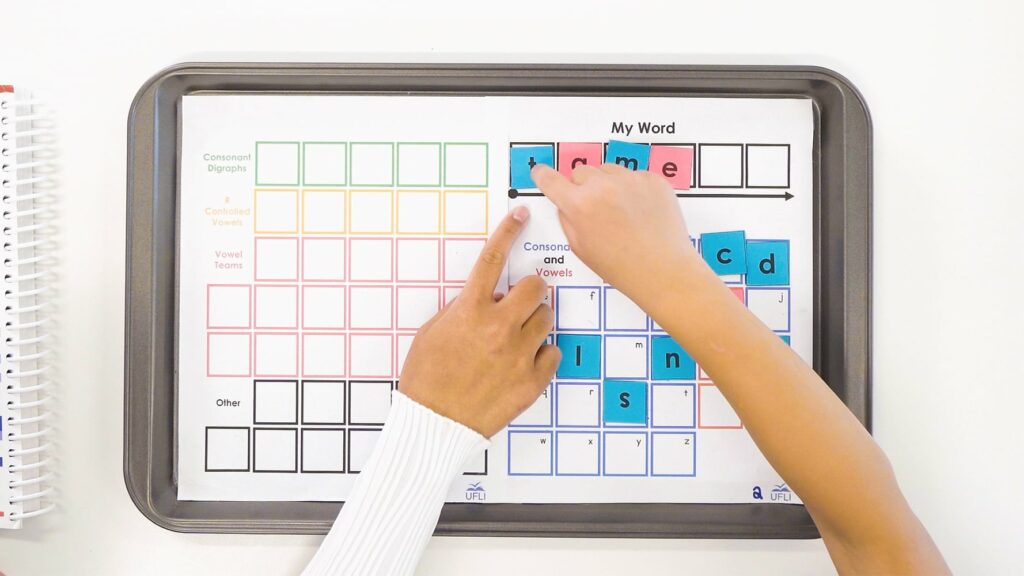Step 2
Introduce new concept
Explicit instruction is clear and direct to prevent confusion. Your lessons should follow the gradual release of responsibility steps:
- I do – Model and demonstrate how the new phonics concept works with examples.
- We do – Guide the student as you practice the new concept together.
- You do – Observe and support the students as they practice using the new concept.
Explicit instruction of new concept
Instructions for explicit instruction of each new concept are available in UFLI Foundations: An Explicit and Systematic Phonics Program available for purchase in Canada through Caversham Booksellers.
Introduce a new grapheme and corresponding sound. Be sure to follow UFLI’s instructions for new concepts. Remember, a grapheme is a letter or a group of letters that makes one sound.
You can find many free supporting resources in the UFLI Toolbox. Scroll down to find specific resources for each UFLI lesson.
Example from UFLI: Lesson 54
“We have learned that A spells ă as in apple. /ă/ is a short vowel sound. A also has a long vowel sound: /ā/ as in acorn. The long vowel sound is the same as the vowel’s name A, /ā/
A spells /ā/ when there is a silent E at the end of the word, like in the words made and tape. The silent E makes vowels say their names, or long vowel sounds. Remember, the E does not make a sound; it is silent.
(Display the word ‘tap’). This word is tap /t/ /a/ /p/. The A is making a short sound: /ă/. Watch what happens when I add silent E. (Display the word ‘tape’). Tap becomes tape /t/ /ā/ /p/. The silent E made the A say its name. (Repeat modeling with cap and cape and mad and made).”
Word building
In the review step, you taught phonemic awareness with sounds only, not letters. Current research shows it’s effective when you also use letters with sounds to read and write words. Part B: Word Building helps the student match letters (graphemes) to sounds (phonemes).
Note: For students in the partial alphabetic phase, you can use the Alphabet Arc instead of Elkonin boxes.
Model how to use Elkonin boxes and tiles with new concept grapheme.
Example: Leading lesson 54 with Ali, use letter tiles or magnetic letters and Elkonin boxes to change words from short vowels to long vowels using the magic E.


Using Elkonin boxes and letter tiles, ask your student to build new concept words.
Word reading and spelling
Read
Ask your student to decode words from the new concept word list. Use I do, we do, you do.
- I do – Model how to read the word by pointing to each letter, then blend them together. – /t/ /a/ /p/ – “tape”
- We do – “Say it with me – ttt aaa ppp.”
- You do – Ask the student to read other words on the word list. Guide them if they need support.


Spell
Dictate new concept words to your student and ask them to spell the words, following the Say it, Tap it, Map it sequence.
Example from UFLI: lesson 54
| Read | Spell |
|---|---|
| I do: made, came | I do: ate, lake |
| We do: make, same, take, name, gave, late, games, state, skate | We do: came, made, late, makes |
Practice correct letter formation as needed.


Observe student understanding.
If this concept comes easily and the student reads and spells most of these words correctly, that shows you they are ready to move on in the scope and sequence next time you meet.
Tips!
Try to keep the pace of instruction brisk and fun!
If your student is not understanding the concepts, try similar activities next time using different materials (“writing” in sand, shaving cream, magnetic letters instead of letter tiles, etc.).
Resources
This resource provides templates that will help you teach correct letter formation organized by hand movements.
Look at UFLI’s digital resources page for more information and ideas.
Check out this video with Strategies for Active Learners.